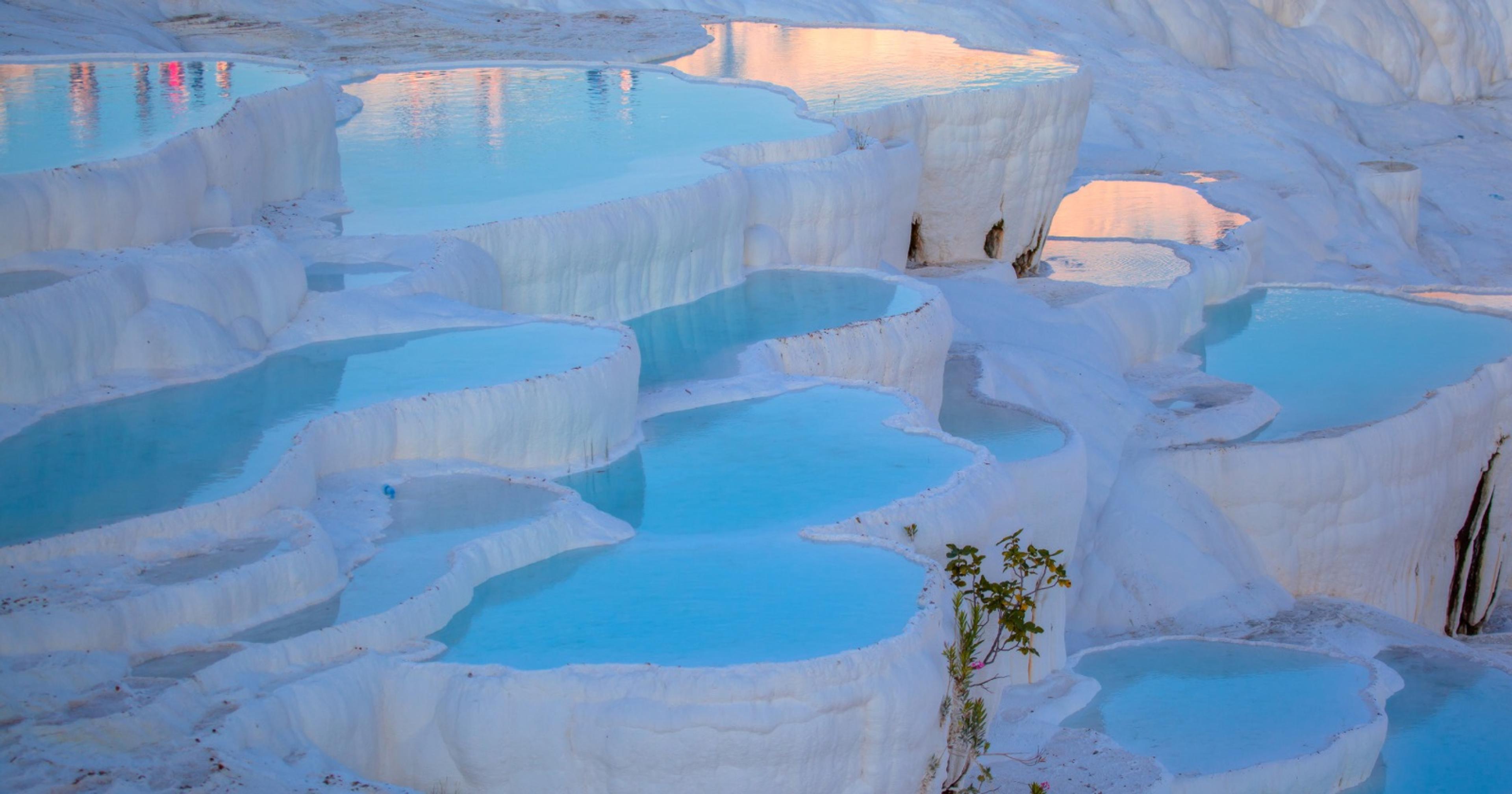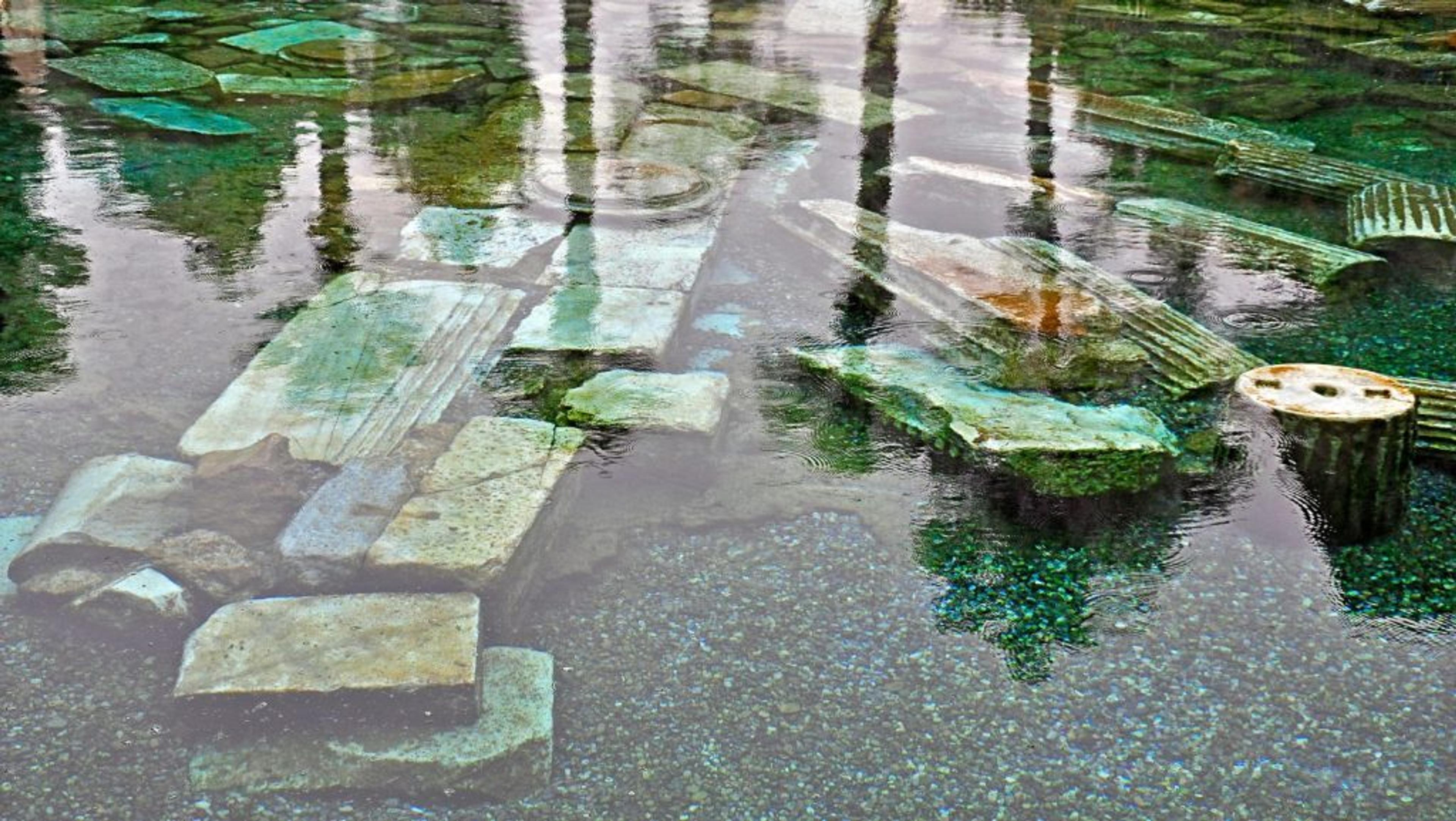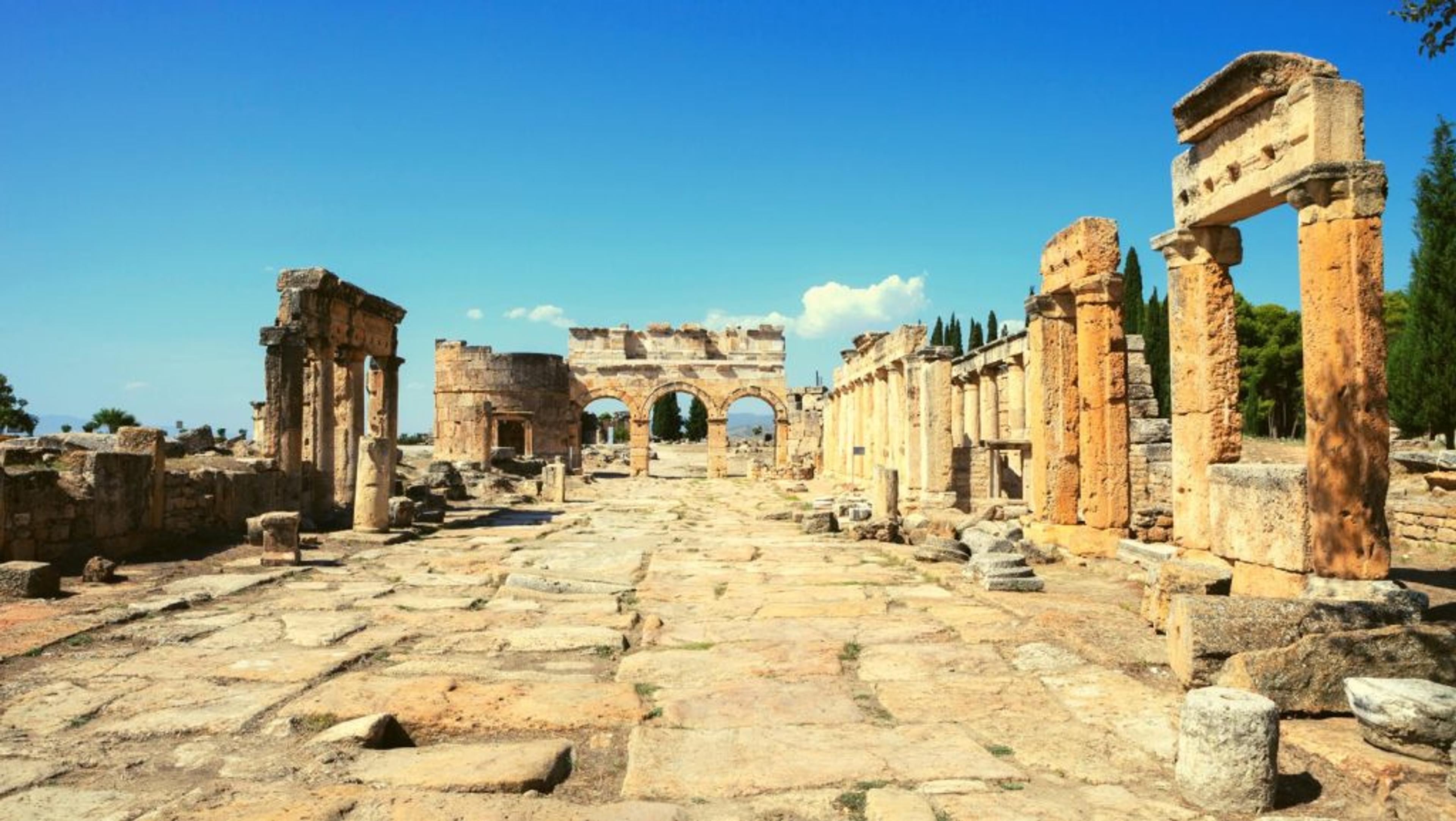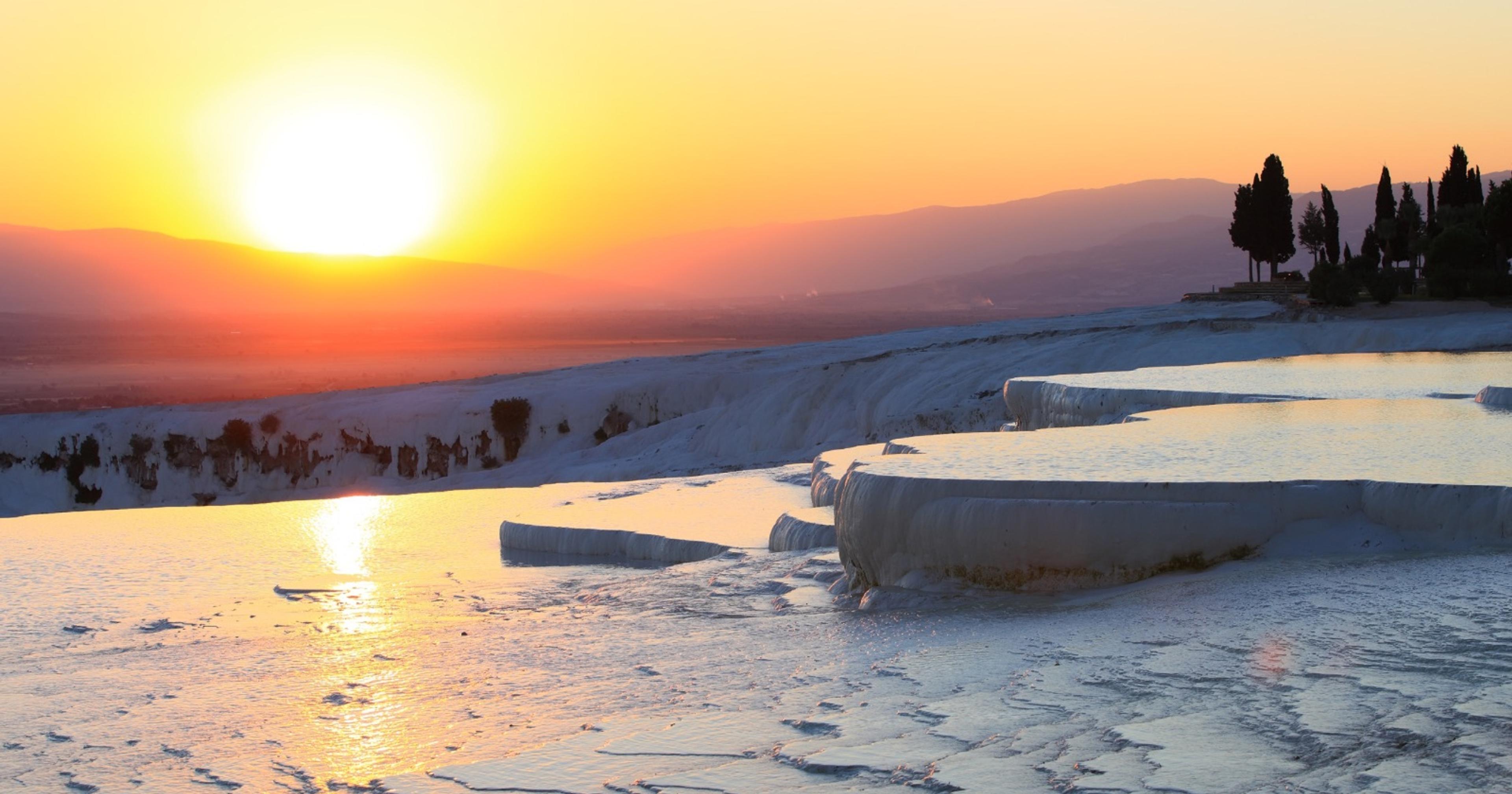It’s not a surprise that after my first trip to Pamukkale (which translates to “Cotton Castle” in Turkish), I was completely smitten with the otherworldly travertine terraces and the ancient ruins that sit just behind them.
Located in southwestern Turkey’s Denizli Province, Pamukkale is a UNESCO World Heritage Site famous for its gleaming white calcite shelves filled with mineral-rich turquoise water. These natural pools, formed by centuries of flowing hot springs, appear so surreal you’ll feel like you’ve stepped onto an alien planet.
In this guide, we’ll dive into 15 incredible things to do in and around Pamukkale, so you can make the most of your visit to this magical corner of Turkey.
1. Marvel at the Travertine Terraces

The travertine terraces are undoubtedly the crown jewel of Pamukkale. Formed by the calcium-rich hot springs that cascade down the cliffs, these layered, cottony-white formations sparkle under the sun.
As you stroll across the terraces, you’ll feel like you’re walking on clouds—just remember that you must remove your shoes to help preserve this fragile environment.
Dip your toes in the warm, shallow pools and let the mineral water soothe your feet as you take in the panoramic view of the surrounding valley.
Tips:
To avoid the crowds and enjoy a more serene experience, aim to visit early in the morning or later in the afternoon. The sunrise and sunset light cast gorgeous pastel hues across the terraces—perfect for photographers chasing that golden glow.
2. Explore the Ancient City of Hierapolis
Just above the travertine terraces lies the ancient Greco-Roman city of Hierapolis, which was founded around the 2nd century BC.
Hierapolis once thrived as a spa city, thanks to the very same mineral-rich springs you can enjoy today. Strolling along the ancient streets, you’ll encounter well-preserved ruins that whisper stories of a bygone era: the monumental Frontinus Gate, the remains of a grand agora, and the city’s impressive walls.
Must-See:
The Theater of Hierapolis is one of the most striking highlights here, boasting intricate stone carvings and a seating capacity of around 12,000.
Climb to the top rows for a sweeping view of the stage and the dramatic landscape beyond.
3. Take a Dip in Cleopatra’s Antique Pool

Known as the Antique Pool or Cleopatra’s Pool, this is said to be where the Egyptian Queen Cleopatra herself once bathed—though that part may lean more on legend than fact.
Still, there’s no denying the allure of this pool: warm, thermal spring water bubbles up amid scattered columns and remnants of ancient marble, creating a spa-like setting you won’t find anywhere else.
Swimming here feels like dipping into history, with every ripple reflecting thousands of years of stories.
What to Know Before You Go:
• There’s an extra entrance fee to swim in Cleopatra’s Pool.
• Arrive early in the day or late afternoon to avoid peak crowds and enjoy a more tranquil soak.
• Changing rooms and lockers are available, but bring your own towel if possible.
4. Visit the Hierapolis Archaeology Museum

If you’re eager to dig deeper into the region’s history, the Hierapolis Archaeology Museum offers a treasure trove of artifacts and sculptures.
Located in the former Roman Bath complex, the museum houses statues, sarcophagi, and other relics from Hierapolis, Laodicea, Tripolis, and other ancient cities in the area.
Wandering through its halls, you’ll gain insight into the region’s multicultural past, where Greek, Roman, and Byzantine influences intermingle.
Don’t Miss:
Look out for the beautifully carved sarcophagi, which provide glimpses into the artistry and beliefs of the era.
The museum is relatively small, so you can comfortably explore it in under an hour, making it a perfect stop before or after traversing the ruins.
5. Witness the Sunset from the Cotton Castle

While the travertines are stunning at any time of day, there’s something truly magical about watching the sun dip below the horizon from “Pamukkale’s Cotton Castle.”
As the sky shifts to pink and orange, the white terraces glow with a soft, golden light. It’s a moment that feels almost too dreamy to be real, and the changing hues of the sky reflected in the water make for postcard-perfect photos.
Photography Tip:
For the best angles, walk up or down the travertine path slowly. Each level offers a different vantage point, and you’ll likely find new perspectives of the terraces and the valley below.
6. Indulge in a Pamukkale Hot Air Balloon Ride
If you’ve been seduced by the idea of hot air balloon rides in Cappadocia, then you’ll be thrilled to know that Pamukkale also offers its own enchanting ballooning experience.
Drifting over the white terraces at sunrise, with the ancient ruins of Hierapolis in the background, is something out of a dream. The flight usually lasts about 45 minutes to an hour and price 80USD, offering panoramic views of Pamukkale’s surreal landscape.
What to Expect:
• Early morning pick-up from your hotel (often before sunrise).
• A short safety briefing before boarding the balloon basket.
• Celebratory tea or juice after landing, sometimes accompanied by a small certificate to commemorate the experience.
7. Go Paragliding for an Aerial Thrill
For an adrenaline rush with incredible scenery, consider paragliding over Pamukkale. Tandem paragliding flights launch from the nearby hills and provide an exhilarating view of the travertines, Hierapolis, and the sprawling valley below.
If you have a taste for adventure, this is one of the most unique ways to take in the landscape, as you’ll soar silently through the sky, carried by the thermal currents that have shaped this region for millennia.
8. Discover the Red Springs of Karahayit
Just a few kilometers from the white terraces, Karahayit offers a fascinating contrast: hot springs that leave red, rust-colored mineral deposits. The color may not be as visually striking as Pamukkale’s whiteness, but it’s still impressive and well worth a visit. The water here has a different mineral composition, reputed for its healing properties that can help with various ailments like rheumatism and skin conditions.
What to Do There:
• Enjoy a soak in one of the small public pools or private hotel spas.
• Stroll around the village to purchase local handicrafts.
• Sample gözleme (Turkish stuffed flatbread) at a local eatery.
9. Venture to the Lesser-Known Kaklık Caves
Kaklık Caves, often referred to as the “Underground Pamukkale,” is a hidden gem about 40 km from Pamukkale. Inside this cavern, mineral-rich waters flow over limestone formations, creating tiny stalactites and travertine-like pools—but underground. The natural lighting that filters in through openings in the cave ceiling gives it an ethereal glow.
Plan Your Visit:
• The cave can be explored in about 30 minutes to an hour.
• Wear non-slip shoes because the walkways can get damp and slippery.
• The surrounding area also has some hot springs and a picnic spot, perfect for a laid-back afternoon.
10. Day Trip to Laodicea
If you’re a fan of ancient history, add a day trip to the ancient city of Laodicea (Laodikeia) to your itinerary. Located around 10 km from Pamukkale, Laodicea was an important trade center in the Roman province of Asia.
Today, you can wander among the extensive ruins that are still under active excavation: colonnaded streets, a well-preserved stadium, multiple theaters, and the remains of an early Christian church.
Why Go:
• Fewer crowds than Hierapolis, giving you a more intimate archaeological experience.
• The city’s layout provides insights into how Roman provincial towns were organized.
• The ongoing excavations might let you witness history literally being unearthed.
11. Indulge in Local Cuisine
Turkish cuisine in this area leans on fresh produce, succulent meats, and hearty soups. Be sure to try çorba (soup) like mercimek (lentil) or ezogelin (spiced red lentil), and sample local grilled dishes such as şiş kebab and köfte.
Vegetarian-friendly options like gözleme stuffed with spinach and cheese are plentiful.
Top Picks:
• Lamuko’s Lokanta in Pamukkale Village: Delicious home-style cooking.
• Local Cafés near Hierapolis: For quick bites like tost (grilled cheese sandwich) or börek (flaky pastry).
• Denizli City Center: If you can venture into Denizli, you’ll find a wider range of restaurants, including fine dining and more global flavors.
12. Shop for Souvenirs in Pamukkale Village
Pamukkale Village, the main gateway to the travertine terraces, has a number of shops selling souvenirs, textiles, and local products. While it can be a bit touristy, you can still find some unique items if you look carefully: handmade ceramics, beautiful scarves, and locally produced olive oil soaps.
Don’t be shy about haggling; bargaining is part of the culture, though do it with a friendly smile.
Souvenir Suggestions:
• Evil Eye Charms (Nazar Boncuğu): Believed to ward off bad luck.
• Turkish Delight: Flavored with rose, pistachio, or pomegranate, makes a sweet gift.
• Handmade Towels: Turkey is famous for its cotton textiles, and what better place to buy them than “Cotton Castle”?
13. Admire the Architecture of the Pamukkale Mosque
To get a sense of local life and culture, take a few minutes to visit the mosque in Pamukkale Village. Its minaret and modest design contrast with the grandiose ruins up the hill, but it provides a glimpse into the day-to-day spiritual fabric of Turkish communities. Remember to dress modestly and remove your shoes before entering.
Tips:
Even though many tourist areas are quite relaxed, it’s important to respect the mosque’s customs.
14. Make a Side Trip to Lake Salda
If you have extra time, consider a day trip to Lake Salda, located about 1.5 to 2 hours’ drive from Pamukkale. Often dubbed the “Turkish Maldives,” Lake Salda boasts powdery white sand and strikingly clear, turquoise water.
Unlike the travertine pools at Pamukkale, Lake Salda’s beauty is entirely natural, formed by mineral deposits and a unique ecological environment.
Why You’ll Love It:
• Swimming in ultra-clear water that shifts from pale blue to deep teal.
• Serene beaches far removed from tourist crowds.
• Picturesque mountain backdrops for a calm, nature-infused day away from the hustle of Pamukkale.
15. Take a Rest and Reflect in a Local Tea Garden
After days of hiking among ancient ruins and soaking in thermal pools, sometimes the best thing to do is take a breather. Turkish tea (çay) is an integral part of local culture. Find a traditional tea garden—often a simple, open-air space under the shade of a giant tree or near a babbling fountain—and take a seat at a wooden table. Order a glass (or two) of piping-hot çay or maybe a Turkish coffee, and let time slow down. This is where you’ll see families chatting, locals reading newspapers, and travelers comparing notes on their Pamukkale adventures.
Sip & Savor:
• Turkish tea is typically served in small tulip-shaped glasses.
• Try it with a cube of sugar, or if you’re feeling adventurous, sample the local honey.
• Pair your tea with simit (a sesame-seed bread ring) or a sweet pastry for an authentic experience.
Where to Stay Near Pamukkale
Because Pamukkale is a relatively small village, most accommodations are within walking distance or a short drive from the travertine entrance. Here are a few categories to consider:
1. Mid-Range Comfort:
• Melrose House Hotel – A family-run spot with a lush garden, delicious breakfasts, and friendly service.
• Bellamaritimo Hotel – Known for its rooftop terrace and pool, offering a great view of the travertine terraces.
2. Budget-Friendly:
• Venus Hotel – Simple but comfortable rooms and a good on-site restaurant.
• Mustafa Hotel – Basic amenities but warm hospitality, a short walk to the main sites.
3. Splurge:
• Spa Hotel Colossae Thermal – A bit further from the center, but boasts thermal pools and spa facilities. Ideal if you’re craving an upscale wellness experience.

